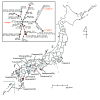Extremely Low Genomic Diversity of Rickettsia japonica Distributed in Japan
- PMID: 28057731
- PMCID: PMC5381555
- DOI: 10.1093/gbe/evw304
Extremely Low Genomic Diversity of Rickettsia japonica Distributed in Japan
Abstract
Rickettsiae are obligate intracellular bacteria that have small genomes as a result of reductive evolution. Many Rickettsia species of the spotted fever group (SFG) cause tick-borne diseases known as "spotted fevers". The life cycle of SFG rickettsiae is closely associated with that of the tick, which is generally thought to act as a bacterial vector and reservoir that maintains the bacterium through transstadial and transovarial transmission. Each SFG member is thought to have adapted to a specific tick species, thus restricting the bacterial distribution to a relatively limited geographic region. These unique features of SFG rickettsiae allow investigation of how the genomes of such biologically and ecologically specialized bacteria evolve after genome reduction and the types of population structures that are generated. Here, we performed a nationwide, high-resolution phylogenetic analysis of Rickettsia japonica, an etiological agent of Japanese spotted fever that is distributed in Japan and Korea. The comparison of complete or nearly complete sequences obtained from 31 R. japonica strains isolated from various sources in Japan over the past 30 years demonstrated an extremely low level of genomic diversity. In particular, only 34 single nucleotide polymorphisms were identified among the 27 strains of the major lineage containing all clinical isolates and tick isolates from the three tick species. Our data provide novel insights into the biology and genome evolution of R. japonica, including the possibilities of recent clonal expansion and a long generation time in nature due to the long dormant phase associated with tick life cycles.
Keywords: generation time; genome evolution; intra-species genomic diversity; intracellular bacteria; rickettsia.
© The Author(s) 2016. Published by Oxford University Press on behalf of the Society for Molecular Biology and Evolution.
Figures



References
-
- Ando S, Fujita H. 2013. Diversity between spotted fever group rickettsia and ticks as vector (in Japanese; an English abstract available). Med Entomol Zool 64:5–7.
-
- Balashov YS. 1972. Bloodsucking ticks (Ixodoidea)—vectors of diseases of man and animals. Miscellaneous Publications of the Entomological Society of America 8:159–376.
-
- Burgdorfer W, Brinton LP. 1975. Mechanisms of transovarial infection of spotted fever Rickettsiae in ticks. Ann N Y Acad Sci. 266:61–72. - PubMed
Publication types
MeSH terms
LinkOut - more resources
Full Text Sources
Other Literature Sources
Molecular Biology Databases
Miscellaneous

